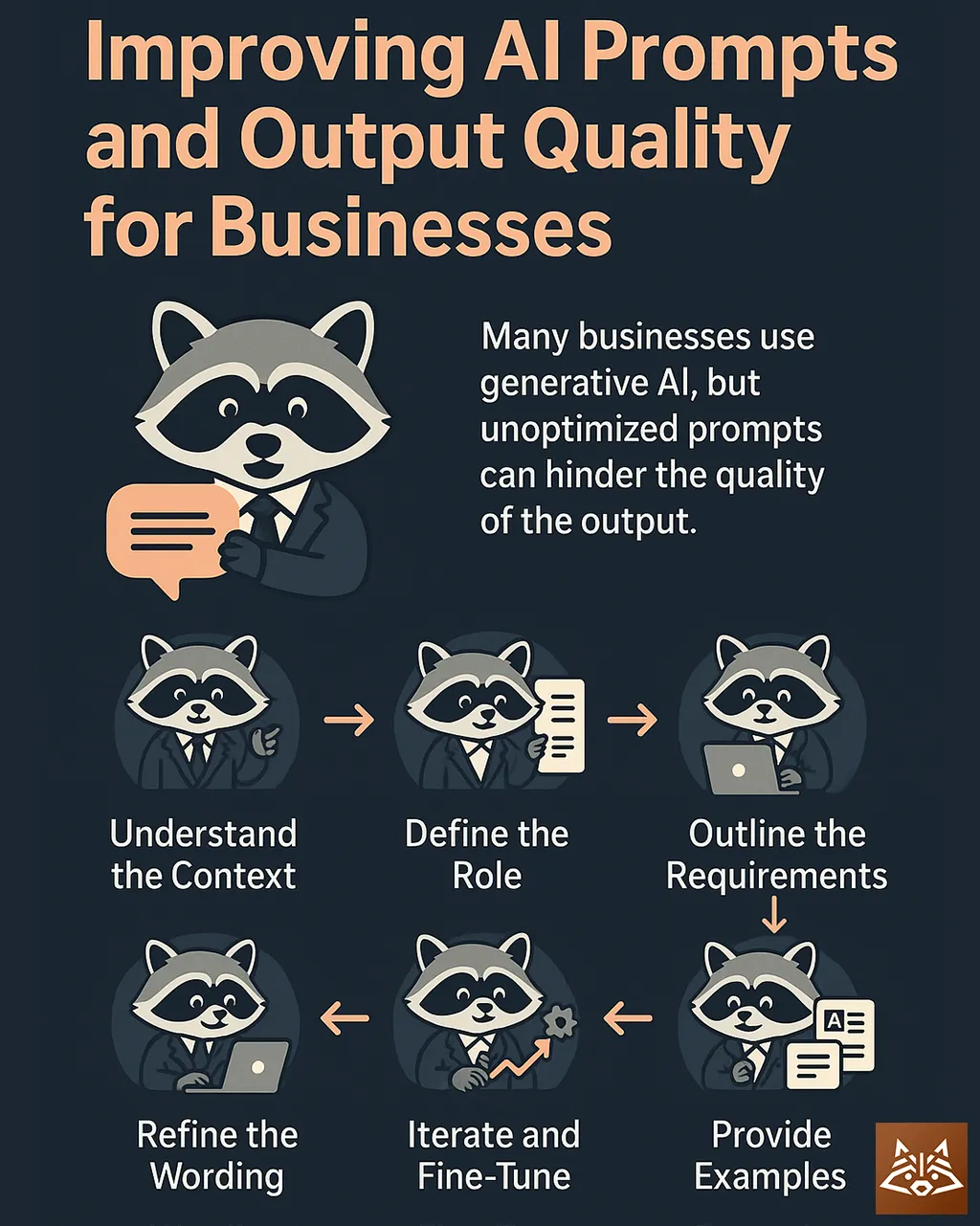The Adoption Paradox
A McKinsey global survey shows that 71 % of organisations already use generative AI in at least one function—almost double 2023’s figure. Yet less than 20 % report enterprise-level profit impact. Our fieldwork confirms the gap: most teams rely on short, “friend-style” prompts that invite casual, surface-level answers. The solution is systematic prompt engineering, not a bigger model. Many of our clients were surprised how good an AI model can be, when it's prompted in the right way.
7 True Tactics to Elevate AI Output
Mind-set first: Before typing a single word, articulate the objective, audience, constraints and success metrics in plain language. Treat the prompt as a design brief, not a magic spell. The AI is your assistant, who knows a lot, but needs guidance throughout the conversation to excel fully.
Tactic 1 — Deep Context Framing
Why it matters: LLMs reason better when the task is grounded in real-world detail and contains the full context. How: Start every prompt with a “business snapshot”: mission, target persona, desired action, and any must-use data points. Example:
Context: Neoground GmbH, B2B AI consultancy near Frankfurt.
Draft an eloquent 300-word proposal summary for an automotive supplier CEO… Clients who added a context block reduced editing time by 40 %, according to our internal QA logs. This can also be stored inside the AI system. Most solutions provide nowadays a way to store general information, so that the basics are always available. Like in our blog post here right now: Our model (o3) knows everything important about our company and our style. So we can fully focus on the content in our input prompt. And it took just 2 iterations to get this result, which we then refined into the final blog post.
Tactic 2 — Assign an Expert Persona
LLMs mirror the role you give them. Stating “You are a senior supply-chain analyst with 15 years in automotive logistics” raised relevance scores in a pilot with a logistics client.
Ever thought about a specific topic and once you got into flow, you remember more and more about that topic and how it relates to similar domains? AI works in a similar way. With a clear role or domain to think about, it's more likely to provide insights and ideas in that regard too.
Tactic 3 — Specify Deliverable & Format
Tell the model what to return and how: bullet list vs. narrative, required headers, length limits, citation style. This eliminates re-prompt loops and halves drafting time.
When it comes to marketing and official documents, you want a consistent style. Create a small style guide and pass it along your specific requirements, so that the overall tone and style is coherent.
Tactic 4 — Chain-of-Thought & Self-Critique Loops
Prompt the model to think aloud, then ask it to review its own reasoning or generate an adversarial critique. Academic work on “Active-Prompting” shows a 7 % boost in exact-match accuracy over standard self-consistency, see: A Systematic Survey of Prompt Engineering in Large Language Models: Techniques and Applications.
Quick template:
(1) Draft solution with step-by-step reasoning
(2) List potential flaws
(3) Rewrite, addressing each flaw You can also guide this process yourself. Make the chat a brainstorming session first, let the AI reflect your thoughts and put them into context. Discuss new ideas, try to get the AI model to its limits. Be a critic or try to provide additional controverse input which irritates the AI and its idea. Just like in a stress test.
Tactic 5 — Build a Modular Prompt Library
Gartner peer-community leaders report higher adoption when teams share ready-made prompt snippets rather than reinventing each time: How are you addressing prompt engineering in your organization?. Store your tone guide, legal boilerplate and background facts as variables; assemble on demand.
Just like mentioned before, have a list of prompt snippets ready for your use cases, and share them within the team so that everyone gets consistent results.
Tactic 6 — Blend Retrieval or Fine-Tuning for Domain Consistency
For regulated or brand-sensitive text, connect the LLM to an internal knowledge base (RAG) or fine-tune on historical documents. This shifts the model from “generic Internet voice” to “your voice” and keeps marketing copy on brand.
But always keep privacy in mind. In most cases it's more useful to invest a bit of time and create suiting input prompt templates. Or to create a PDF or other large document containing the key information needed in that regard.
Tactic 7 — Inject Beneficial Friction & KPIs
MIT research shows that adding “speed bumps” (e.g., highlighting uncertain claims) improves factual accuracy without slowing users down: To help improve the accuracy of generative AI, add speed bumps | MIT Sloan. Pair these UI nudges with a simple output-quality scorecard (clarity, accuracy, tone, originality) so teams can quantify gains and iterate.
How to Think: A Meta-Framework
- Define: Goal, audience, constraints, success metric.
- Design: Choose persona, context, format.
- Draft: Generate first output with chain-of-thought visible.
- Diagnose: Use self-critique or human review; score against metrics.
- Develop: Refine prompt or feed back corrections; store successful versions in the library.
- Deploy: Automate via templates, shortcuts or API calls.
- Document & Share: Version-control prompts so improvements compound.
This mirrors the “targeted friction → continuous improvement” loop highlighted in MIT Sloan’s 2025 study on human–AI collaboration and echoes OpenAI’s guidance that AI leaders grow 1.5× faster yet only 1 % feel “fully mature”. Read more here: When humans and AI work best together — and when each is better alone.
More Real-World Examples
- Marketing: A SaaS client feeds every prompt with a 120-word tone card plus last campaign metrics. Click-through rates rose 32 % quarter-over-quarter.
- HR: Using a role-specific prompt—“You are an I/O psychologist…”—cut bias flags in job descriptions by 48 %.
- Product: Dual-persona prompting (optimist vs. devil’s advocate) streamlined roadmap debates, saving one sprint per quarter.
Ready to Unlock Expert-Level AI?
Stop settling for “good-enough” generations. Neoground audits your current workflows, builds bespoke prompt libraries, and trains your team to think—and prompt—like pros. Message us today to start turning every prompt into business gold.
Oh and last but not least—here's our summary as a beautiful infographic:

This article was created by us with the support of Artificial Intelligence (GPT-o3).
All images are AI-generated by us using Sora.




Noch keine Kommentare
Kommentar hinzufügen